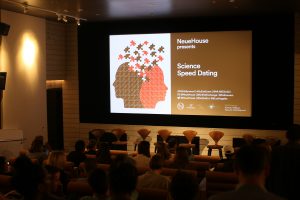
Our first date set the tone, dressed for the occasion. A suit with a turquoise shirt, silver hoops in his ears, pins on his lapel, and boots with flames coming up over the toes. The wine was chilled, the lights were dimmed, and the clock had started ticking. He spent seven minutes on the weather and hot gas. Science speed dating had begun.
While not ideal topics on a true first date, weather and gas are riveting in the hands of an astrophysicist. Dr. C. Alex Young clued us into his work at NASA’s Goddard Space Flight Center, where he studies the seething hot gas and shifting magnetic fields that make up space weather.
“Space is a seething soup,” said Young, full of invisible yet potent forces with vast implications for us earthlings. Looking to the future, we will need to protect ourselves from it, and maybe even harness it, to explore the galaxy. Looking to the past, we must consider how it impacted early life on Earth, and wonder if it fanned that spark of life.
Fortunately, from down here, we can experience it as one of the natural wonders of the world: shimmering auroras over Earth’s poles, byproducts of the interaction between scorching gas ejected by the sun and Earth’s magnetic field.
Dr. Joaquín Madrenas then stepped up to shrink the scale down to the level of Staphylococcus aureus—the bacteria responsible for MRSA infections that, in all likelihood, are roosting in the nose of at least one of the presenting scientists.
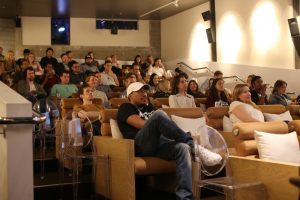
Recent research indicates that approximately 25% of the healthy human population carries the bacteria for life, primarily in their nostrils, with another 25% carrying it intermittently. It is a textbook commensalistic relationship: the bacteria gets a great living situation, and we, the hosts, are otherwise undisturbed.
But that relationship can become compromised. If the carrier becomes immunosuppressed, or requires major surgery, then he/she is at a much higher risk of infection—and the treatment of toxic shock brought on by infections of S. aureus still eludes modern medicine. Fortunately, progress has been made: a 13% decrease in MRSA blood infections was noted between 2011 and 2014.
With a mischievous smile, Madrenas presented us with two photos of the queen of England. In one she was picking her nose, and in the other shaking the hand of the former leader of the IRA. He left us to our own opinions about whether that constituted bioterrorism.
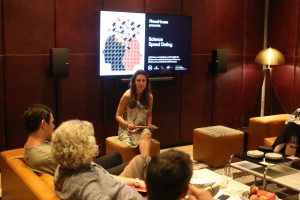
Olivia Osborne
We stayed small with Dr. Olivia Osborne of the California nanoSystems Institute at UCLA. She informed us that there are already around 2,000 consumer nanotech products on the market, operating on the scale of 1–100 nanometers (about 1 billion times smaller than the average car tire).
These materials are about as big as proteins, DNA molecules, and viruses; smaller than the body can even detect; and are capable of interacting directly on the bio-interface level. An entire frontier of medicine—full of potential for self-assembling nanoparticles and targeted treatments that attack the very root of a disease—now lies within our reach. But a realm that small is tough to regulate.
The risk of negative bioaccumulation, where nanoparticles slowly aggregate to form concentrated toxic pockets is very real and very dangerous. Think rising mercury levels in fish—the little bit we pick up from every filet is not necessarily dangerous on its own, but the more fish we eat, the more mercury gets into our systems, doing increasing amounts of damage.
By examining the zebrafish, which shares 80% of the human genome and lays transparent eggs that rapidly develop into visible embryos, Osborne can examine the effects of nanoparticles in real time across all stages of development. In the end, she says, “size does matter.”
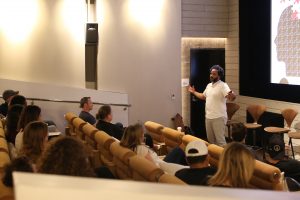
Tahir Hemphill
After nano comes audio, as Tahir Hemphill dove into the intersection of art, analytics, and hip hop. Hemphill has taken a vast catalog of rap and ingested it into the Hip Hop Word Count database, parsing release date, location, lyrics, and more to mine the wealth of ethnographic data found across decades of music. Like reading an archeological record, he can chart trends in style and subject to examine the issues from which hip hop music is born.
Further inspired by hidden data in hip hop, as well as Picasso’s light pen drawings, Hemphill went through the entire available discography of 12 prominent rappers, from Jay-Z to Missy Elliot, noting each location mentioned in their music. Using long exposure videography and a robotic arm, his Picasso, Baby! project mapped each location in mid-air, producing fascinating art from a trove of geographic data; data that allowed him, for example, to chart the increasing influence of artist Jean-Michel Basquiat throughout the genre. The examination of systems like these and how they influence form is central to Hemphill’s work, allowing him to generate data that can be used by communities at large to breed resilience.
Phil Ross arrived with an intricate system of his own—vast, interconnected, and underground. He began his career combing the woods of upstate New York on behalf of gourmet restaurants, searching out the kind of premium cooking mushrooms we cannot quite cultivate yet. He became intimately familiar with the fungi, making use of his artistic talent to draw and memorize the details that separate delicious from deadly.
Increasingly mesmerized by mushrooms, he made use of them as a chef, studied them as a mycologist, and, most recently, decided to bring them on as business partners. His company MycoWorks makes use of the dense network of root-like structures produced by mushrooms, called mycelia, to create a revolutionary building material.
Just like plant roots in soil, mycelia anchor what they grow in. In a medium like sawdust, they will take hold and form an incredibly strong, brick-like material that can be used for architectural purposes. The mushroom itself, a species traditionally used in Eastern medicine known as Reishi, can be harvested and used for many things—even to create a leather substitute virtually indistinguishable from the real thing.
But what if we could train our skin to smell these mushrooms or to see the aurora’s magnetism or to visualize the vibrations of a Kanye West song? Zach McKinney, co-founder of Spinal Singularity, envisions this world where our skin can do more.
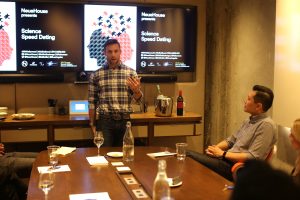
Zach McKinney
Every time your phone vibrates, you are receiving a tactile form of information called haptic feedback. McKinney and his team have found that our skin can do more than just receive this type of feedback—it can act on it and produce a feedforward response, prompting action without us even needing to think about it.
For those with spinal cord injuries, the prospect of ever walking again is a slim one. The neural circuitry responsible for such an action is often wired below the site of the injury, cutting off our conscious access to it. But preliminary research has demonstrated that a combination of pressure stimulation of the foot and electrical stimulation of the spinal cord can trigger those neural subroutines, allowing spinal cord injury patients to regain a degree of mobility.
And what speed-dating event would be complete without a discussion about Pixar movies? And future children? And robots? Dr. Maja Mataric, enjoying the recent surge of funding and interest in her twin fields of robotics and computer science, spoke to us about a WALL-E future. We are both physical and social animals, she said, tied to life by our motivation. While not quite at the isolated, immobile, screen-surrounded society shown in the film, we are beginning to see some startling trends to that effect.
With the advent and availability of personal technology, the way humans interact with each other is changing, particularly in children. At least one study has shown that today’s 12-year-olds have the social skills of only 8-year-olds, indicating we now live in a less interactive—and as a result, less empathetic—society. But for the most part, empathy is hardwired in us, a muscle to be flexed and maintained. And if we cannot turn to other humans to help us exercise it, we can at least turn to something humanoid.
Robots can help us tap into our human-to-human interaction abilities, drawing out empathy by virtue of their design and programming. For children with severe social disorders who struggle to develop a group of friends, and even those without, robots could offer a vital outlet of socialization. We may live in a world where the near future sees robots teaching us to be human.
But Mataric highlights the importance of diversity in the development of this technology and in the field at large. Without the breadth of perspective and a variety of contributors, we will not be able to create technology capable of serving all those who need it.
With that, the final countdown ended, and she rose from her seat. “May you live in interesting times,” she finished, and left the room. After a moment, everyone stood and filed out, convinced that that they indeed do.






